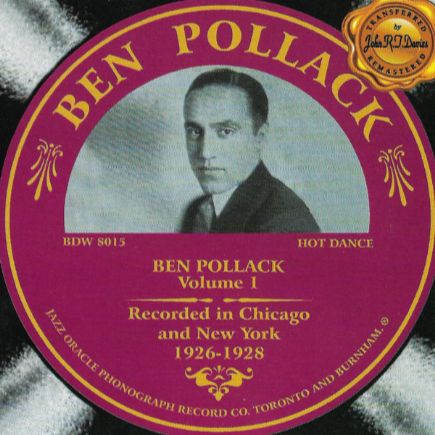Ben Pollack, le père du swing moderne
Batteur, chef d’orchestre et figure clé de l’histoire du jazz américain, Ben Pollack occupe une place charnière entre le jazz traditionnel de La Nouvelle-Orléans et l’ère du swing, qui marquera profondément les décennies 1930 et 1940. Surnommé The Father of Swing, il a contribué à faire évoluer la rythmique, la structure et l’orchestration du jazz, en insufflant à la batterie un rôle moteur et à l’ensemble orchestral une cohésion nouvelle.
Né à Chicago, Ben Pollack découvre très tôt la musique et apprend la batterie en autodidacte. Sa première expérience notable remonte à 1923, lorsqu’il enregistre avec les New Orleans Rhythm Kings, l’un des groupes phares de l’époque, auquel participa également Jelly Roll Morton. Ces premières sessions témoignent déjà d’un sens du rythme affirmé et d’un souci de clarté sonore qui influenceront toute une génération de batteurs.
En 1926, il fonde à Chicago son premier orchestre, Ben Pollack and His Californians, composé de jeunes musiciens appelés à devenir des figures majeures du jazz américain : Benny Goodman, Glenn Miller (remplacé en 1928 par Jack Teagarden) et Jimmy McPartland. Le groupe se produit principalement sur la côte ouest et enregistre de nombreux titres entre Chicago et New York, parmi lesquels Deed I Do et My Kinda Love, qui marquent la transition vers une esthétique plus raffinée et dansante.
Visionnaire et entrepreneur, Ben Pollack s’impose également comme un pionnier dans l’organisation et la gestion d’ensembles de jazz. Dans les années 1930, il dirige plusieurs big bands successifs, naviguant habilement entre les difficultés économiques de la Grande Dépression et la demande croissante pour la musique de danse. En 1934, il fonde le Ben Pollack Orchestra, qui devient rapidement l’un des orchestres les plus populaires des États-Unis. Sa formation, où se côtoient de futurs géants comme Goodman et Miller, contribue à l’émergence du swing et à sa diffusion à travers le pays grâce à des tournées et à une activité discographique intense.
Le groupe de 1935, qui inclut Muggsy Spanier et le jeune trompettiste Harry James, poursuivra son aventure sous la direction de Bob Crosby, marquant ainsi la naissance du Bob Crosby Orchestra. Pollack, lui, crée un nouvel ensemble en 1937, poursuivant son travail de chef d’orchestre et de découvreur de talents. Son influence s’étend également au cinéma: son orchestre apparaît dans plusieurs productions hollywoodiennes destinées au grand public, dont The Glenn Miller Story (Anthony Mann, 1954) et The Benny Goodman Story (Valentine Davies, 1955).
Ben Pollack, el padre del swing moderno
Baterista, director de orquesta y figura clave en la historia del jazz estadounidense, Ben Pollack ocupa un lugar central entre el jazz tradicional de Nueva Orleans y la era del swing, que marcaría profundamente las décadas de 1930 y 1940. Apodado The Father of Swing, contribuyó a transformar la rítmica, la estructura y la orquestación del jazz, otorgando a la batería un papel protagonista y dotando al conjunto orquestal de una cohesión renovada.
Nacido en Chicago, Pollack descubrió la música muy joven y aprendió a tocar la batería de forma autodidacta. Su primera experiencia destacada llegó en 1923, cuando grabó con los New Orleans Rhythm Kings, uno de los grupos más influyentes de la época, que también contó con la participación de Jelly Roll Morton. Aquellas primeras sesiones ya revelaban un sólido sentido del ritmo y una claridad sonora que influirían en toda una generación de bateristas.
En 1926 fundó en Chicago su primera orquesta, Ben Pollack and His Californians, integrada por jóvenes músicos destinados a convertirse en figuras emblemáticas del jazz estadounidense: Benny Goodman, Glenn Miller (sustituido en 1928 por Jack Teagarden) y Jimmy McPartland. El grupo actuó principalmente en la costa oeste y grabó numerosos títulos entre Chicago y Nueva York, entre ellos Deed I Do y My Kinda Love, que marcaron la transición hacia una estética más refinada y bailable.
Visionario y empresario, Pollack también fue pionero en la organización y gestión de conjuntos de jazz. En la década de 1930 dirigió varias big bands sucesivas, sorteando con habilidad las dificultades económicas de la Gran Depresión y respondiendo a la creciente demanda de música de baile. En 1934 fundó el Ben Pollack Orchestra, que pronto se convirtió en una de las orquestas más populares de Estados Unidos. Su formación, que incluía a futuros gigantes como Goodman y Miller, contribuyó decisivamente a la consolidación y difusión del swing mediante extensas giras y una prolífica actividad discográfica.
El grupo de 1935, que contaba con Muggsy Spanier y el joven trompetista Harry James, continuó su trayectoria bajo la dirección de Bob Crosby, dando origen al Bob Crosby Orchestra. Pollack, por su parte, formó un nuevo conjunto en 1937, continuando su labor de director y descubridor de talentos. Su influencia se extendió también al cine: su orquesta apareció en varias producciones de Hollywood destinadas al gran público, entre ellas The Glenn Miller Story (Anthony Mann, 1954) y The Benny Goodman Story (Valentine Davies, 1955).
Ben Pollack, il padre dello swing moderno
Batterista, direttore d’orchestra e figura chiave nella storia del jazz americano, Ben Pollack occupa una posizione cruciale tra il jazz tradizionale di New Orleans e l’era dello swing, che avrebbe profondamente segnato gli anni Trenta e Quaranta. Soprannominato The Father of Swing, contribuì a trasformare il ritmo, la struttura e l’orchestrazione del jazz, conferendo alla batteria un ruolo trainante e all’ensemble orchestrale una nuova coesione.
Nato a Chicago, Pollack scoprì la musica in giovane età e imparò a suonare la batteria da autodidatta. La sua prima esperienza importante risale al 1923, quando registrò con i New Orleans Rhythm Kings, uno dei gruppi più influenti dell’epoca, con la partecipazione anche di Jelly Roll Morton. Quelle prime sessioni rivelarono già un forte senso del ritmo e una chiarezza sonora che avrebbero ispirato un’intera generazione di batteristi.
Nel 1926 fondò a Chicago la sua prima orchestra, Ben Pollack and His Californians, composta da giovani musicisti destinati a diventare icone del jazz americano: Benny Goodman, Glenn Miller (sostituito nel 1928 da Jack Teagarden) e Jimmy McPartland. Il gruppo si esibì principalmente sulla costa occidentale e registrò numerosi brani tra Chicago e New York, tra cui Deed I Do e My Kinda Love, che segnarono il passaggio verso un’estetica più raffinata e danzante.
Visionario e imprenditore, Pollack fu anche un pioniere nell’organizzazione e gestione delle orchestre jazz. Negli anni Trenta diresse diverse big band, destreggiandosi abilmente tra le difficoltà economiche della Grande Depressione e la crescente richiesta di musica da ballo. Nel 1934 fondò il Ben Pollack Orchestra, che divenne rapidamente una delle orchestre più popolari degli Stati Uniti. La sua formazione, che includeva futuri giganti come Goodman e Miller, contribuì in modo decisivo all’affermazione e alla diffusione dello swing, grazie a numerose tournée e a un’intensa attività discografica.
Il gruppo del 1935, che comprendeva Muggsy Spanier e il giovane trombettista Harry James, proseguì la propria avventura sotto la direzione di Bob Crosby, dando vita al Bob Crosby Orchestra. Pollack, invece, formò un nuovo ensemble nel 1937, continuando la sua attività di direttore e scopritore di talenti. La sua influenza si estese anche al cinema: la sua orchestra apparve in diverse produzioni hollywoodiane destinate al grande pubblico, tra cui The Glenn Miller Story (Anthony Mann, 1954) e The Benny Goodman Story (Valentine Davies, 1955).
Ben Pollack, the father of modern swing
Drummer, bandleader, and a pivotal figure in American jazz history, Ben Pollack bridged the gap between traditional New Orleans jazz and the swing era that would define the 1930s and 1940s. Nicknamed The Father of Swing, he helped transform jazz rhythm, structure, and orchestration—giving the drums a driving role and his orchestras a newfound sense of unity.
Born in Chicago, Pollack discovered music early and taught himself to play drums. His first major experience came in 1923, when he recorded with the New Orleans Rhythm Kings, one of the most influential bands of the time, which also featured Jelly Roll Morton. These early sessions already displayed his strong rhythmic sense and clarity of sound, qualities that would inspire an entire generation of drummers.
In 1926, he founded his first orchestra in Chicago, Ben Pollack and His Californians, featuring young musicians destined to become jazz legends: Benny Goodman, Glenn Miller (replaced in 1928 by Jack Teagarden), and Jimmy McPartland. The group performed primarily on the West Coast and recorded numerous titles between Chicago and New York, including Deed I Do and My Kinda Love, marking the transition toward a more refined and dance-oriented aesthetic.
A visionary and entrepreneur, Pollack was also a pioneer in organizing and managing jazz ensembles. During the 1930s, he led several successive big bands, skillfully navigating the challenges of the Great Depression and the growing demand for dance music. In 1934, he founded the Ben Pollack Orchestra, which quickly became one of the most popular dance orchestras in the United States. With future stars like Goodman and Miller in its ranks, the band played a major role in shaping and spreading swing music across the country through constant touring and prolific recording.
The 1935 lineup, which included Muggsy Spanier and the young trumpeter Harry James, continued under the direction of Bob Crosby, leading to the formation of the Bob Crosby Orchestra. Pollack, meanwhile, assembled a new group in 1937, continuing his work as a bandleader and talent discoverer. His influence also extended to Hollywood: his orchestra appeared in several major studio productions, including The Glenn Miller Story (Anthony Mann, 1954) and The Benny Goodman Story (Valentine Davies, 1955).


